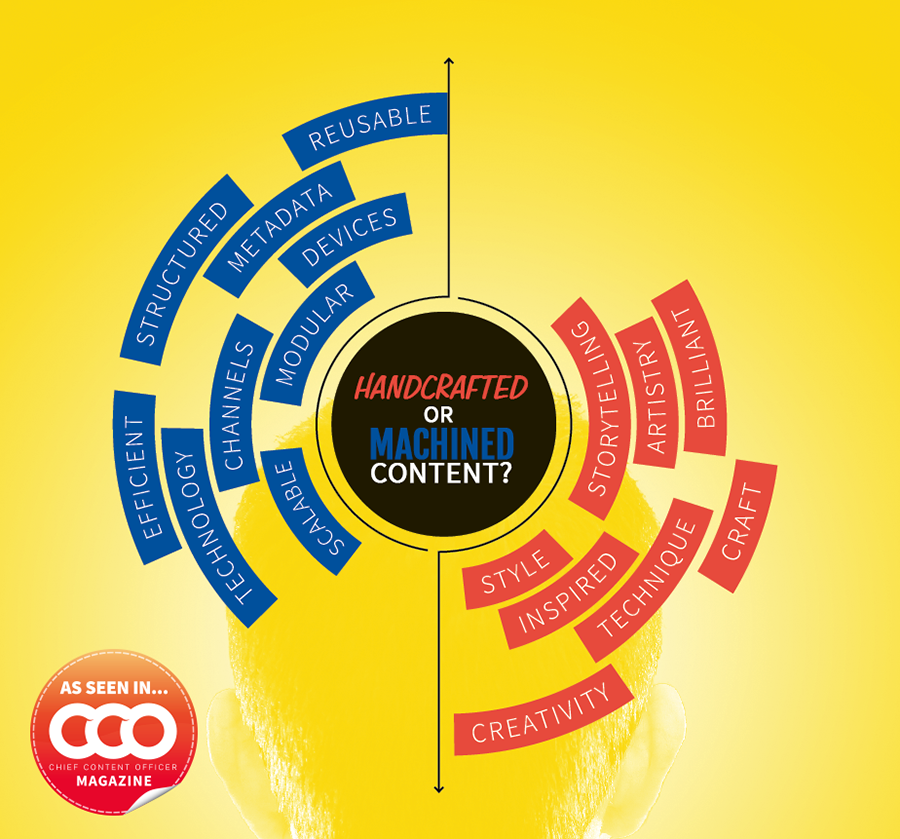A version of this article appeared in the June 2015 Chief Content Officer magazine in an exploration of the debate between machined and handcrafted content. Ann’s argument for machined content is made in these answers (bolding is ours). Want to hear the handcrafted-content side? Read Jay Acunzo’s response on the CMI blog.
What’s the future of content creation?
The future of content creation lies with intelligent content. Only by developing structured reusable content, enriched with metadata and supported by intelligent content technologies, can you hope to meet the ever-changing content needs of your customers and the proliferation of channels and devices they use to consume it.
Is scale a problem for big brands or are all content marketers struggling with it?
Everyone struggles with it. If you’re a small shop and you try to do more than simple content marketing you might find you’re overstretched. But if you incorporate intelligent content strategies to multiply the reach of your content, you can be a so-called small company with a big footprint.
Examples:
- Host a webinar and record it for future access.
- Automatically transcribe the webinar and turn an edited version of the narrative into a white paper or series of articles.
- Structure the content (modularize it and add semantic tags to identify content such as quotes, question and answers, key concepts, etc.).
Once the content is structured and tagged, the main work is done; everything else can be automated. Now you can automatically do things like this:
- Extract the questions and answers (based on tags) and turn them into blog posts.
- Compile the blog posts into a digest post of the top “X” things you need to know.
- Extract key quotes and tweet them.
- Take the same questions, post them to Facebook, and start a conversation.
In some ways, big brands have a harder time scaling because they are frequently siloed and inefficient. Plus they do not always learn from their successes and failures. Marketers should start in a small, manageable area where they can identify pain points, create an intelligent content strategy, and test their processes and technology before scaling up to a broader area. We always say, “Think big, act small.” Plan for the full scope, but start in a small, manageable area.
And don’t feel you have to have all the new gadgets to be successful. Good content delivered in a way that resonates with your customers with a little bit of added technology will be successful.
Can brands be both deeply creative and create content at scale?
Absolutely. We always say “manufacture content, don’t handcraft it.” People often cringe at the concept of manufacturing, thinking it means they are putting out boring black boxes of repetitive stuff. Absolutely not!
Think of cars. Cars come in all shapes, sizes, and colors. Do you think companies redesign the spark plugs for every car, or the wheels, or the engine, etc.? They don’t. They start with all the standard parts and build them into vehicles for a multitude of customers. Car companies spend their time being creative about how cars look and perform; they don’t reinvent all the bits and pieces each time.
I often use the example of Lego blocks. You can take those blocks and build an infinite number of things. Your content needs to be a set of Lego building blocks. Determine an optimum way to structure all the types of content you create so that you can quickly and easily pick up a template and fill in the content.
- Does it include a teaser?
- How long is the teaser?
- Can it be written so it can be tweeted as well as be part of a web page?
- What about extracted for a campaign?
Stop rewriting; stop doing the same things over and over again. Stop wasting your time; design and develop intelligent content. Figure the structure out, pour your content into it, automatically extract content as needed, publish it everywhere! Spend your time on the part that adds value: the content (and yes, that means the creativity)!
Is this the end of handcrafted content?
Authors will still create (craft) the best possible content, communicating it as effectively as possible. What authors won’t do is re-create the same content over and over for each channel and each usage. Instead, they’ll optimize the content up front for use wherever it may appear.
Want more?
- Read Jay Acunzo’s response on the handcrafted-content side of the debate on the CMI blog.
- Sign up for the Intelligent Content weekly email newsletter. Every Saturday we’ll send you pointers to that week’s Intelligent Content blog posts and an exclusive message from CMI Chief Strategy Officer Robert Rose.
- Download our e-book Getting Started With Intelligent Content.
- Sign up to receive your free subscription to our bimonthly print magazine, Chief Content Officer, where Ann’s and Jay’s articles originally appeared.
Cover image by Joseph Kalinowski/Content Marketing Institute


